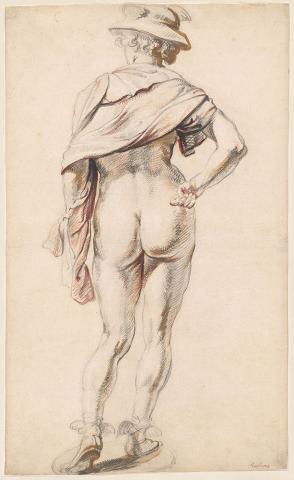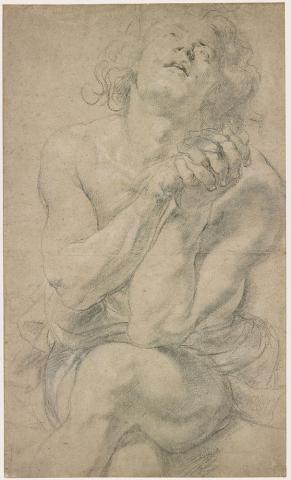
Jacob Jordaens (1593–1678)
Mercury Standing, Seen from Behind, ca. 1620
Red and black chalk, brown wash, red watercolor, and white and brown opaque watercolor
18 1/4 x 11 1/8 inches (464 x 283 mm)
Partial gift of Clement C. Moore II and partial purchase on the Acquisitions Fund, 2019.103
When I left New York for the Salon du Dessin in Paris in late March 2019, I did not expect to fall in love with a Flemish drawing. But somewhere between the opening reception at the grand Palais Brongniart—the historic stock exchange building in Paris—and the flight back to JFK a few days later, this large, colorful study by Antwerp-born Jacob Jordaens had cast its spell on me. Intrigued by its scale, function, degree of finish, and place within Jordaens’s artistic development, I kept returning to the dealer’s booth to study the drawing in person with John Marciari, the Charles W. Engelhard Curator and Department Head, Drawings and Prints. We became increasingly convinced that the drawing would be a meaningful addition to the Morgan’s already impressive collection of seventeenth-century Flemish works on paper.
A contemporary of Peter Paul Rubens and Anthony van Dyck, Jacob Jordaens (1593–1678) was one of the leading painters in seventeenth-century Flanders. Around 450 drawings by his hand survive to our day, ranging from studies of individual figures done from life to highly finished and elaborate compositions made in preparation for prints, paintings, and tapestries. These drawings not only attest to the centrality of the drawing medium in Jordaens’s artistic practice but also reveal his highly idiosyncratic style and technique. As historic guild records show, Jordaens had initially trained as a waterschilder—a watercolor painter who produced large-scale works on paper or canvas that could be used as substitutes for tapestries. It was probably at this time that the artist’s interest in and facility with color, which distinguishes Jordaens’s drawn oeuvre from works by his Flemish contemporaries, began to emerge. The drawing we discovered in Paris, Mercury Standing, Seen from Behind, was executed using a tight system of hatching in black and red chalks, with the addition of red watercolor, and white and brown opaque watercolor, and offers a brilliant example of the complex multicolored technique that Jordaens developed in his drawings during the 1620s and 30s.
Yet it was not only the technical but also the conceptual complexity of the Mercury that kept us returning to the drawing again and again. The work did not allow us to easily answer even the most basic question of art-historical analysis: what were we looking at here? At first glance, it seems evident that the drawing represents the Roman god Mercury, identifiable by his helmet and winged sandals. The artist appears to have based the figure’s pose on an ivory statuette of Mercury designed by Rubens, now at the State Hermitage Museum in Saint Petersburg. Seen from behind, the Mercury in Jordaens's drawing is depicted standing on a round pedestal, in a pose identical to that of the statuette, and is of roughly the same size. Due to a working relationship with Rubens’s studio that commenced in the late 1610s and continued through the 1630s, Jordaens would have had ample opportunity to study and draw inspiration from the works by the older and more accomplished Antwerp artist.

Peter Paul Rubens (1577–1640)
Seated Male Youth, ca. 1613
Black chalk, heightened with white chalk, on light gray paper
19 11/16 x 11 3/4 inches (500 x 299 mm)
Purchased by Pierpont Morgan (1837–1913) in 1909, I, 232
However, instead of faithfully following Rubens’s prototype, Jordaens transformed Mercury’s male frame by giving the figure a distinctly feminine anatomy. He might have achieved this either by arranging a female model in the pose of Rubens’s Mercury, or by studying other works of art. Indeed, the sensual handling of Mercury’s flesh seems to be particularly inspired by drawings made by Rubens in preparation for his statuettes, such as the Venus, Seen from Behind, now at the Louvre. In either case, Mercury Standing is best understood as a kind of ambiguous assemblage, toggling between art and nature, male and female, ivory and skin. Simultaneously indebted to the study of art and of nature, the drawing seems to follow Rubens’s conviction that new art should respond to older art but, ultimately, imitate nature. This idea was one of the central leitmotifs of Power & Grace, a recent exhibition surveying the Morgan’s collection of drawings by Rubens, Jordaens, and Van Dyck. The highlight of that show and one of the greatest Northern drawings at the Morgan in general, Rubens’s marvelous study of a Seated Male Youth offers perhaps the purest encapsulation of this manner of working. As it has long been known, the pose of the male model in Rubens’s work was derived from Girolamo Muziano’s Penitent Saint Jerome, which the artist most likely owned. The drawing, thus, provides further context for understanding Jordaens’s piece.
While technical affinities with Jordaens’s early drawings suggest that the work was produced around 1620, a later dating in the mid-1630s has also been proposed. A companion piece to the drawing, depicting the same statuette frontally, has been at the Harvard Art Museums since 1932. Although equally complex in terms of the handling of media, the Harvard drawing does not trade in the same kinds of ambiguities and offers, instead, a far more conventional rendering of the Mercury, which closely follows the ivory model. Although the two works appear to have been separated by the end of the eighteenth century, they both have letter C inscribed in red chalk at upper left, suggesting a shared early provenance.
After much pondering, research, and extended discussions with colleagues and Jordaens scholars, we purchased the drawing. It finally reached the Morgan in the summer of 2019. The acquisition would not have been possible without the support of Clement C. Moore II, whose longstanding commitment to the Morgan allows us to continue enhancing the library’s holdings of Dutch and Flemish drawings.
Now part of the Morgan’s collection, Mercury Standing continues to pose questions and offer opportunities for further research. For instance, since our understanding of Rubens as a designer of ivories is still far from complete, questions continue to linger about the dating as well as the authorship of the Hermitage statuette and, similarly, the dating of the Jordaens’s drawing itself. Although highly worked, the sheet appears less polished than some of Jordaens’s autonomous drawings, which invites us to think more deeply about the work’s function and meaning.
Austėja Mackelaitė
Annette and Oscar de la Renta Assistant Curator of Drawings and Prints
The Morgan Library & Museum

